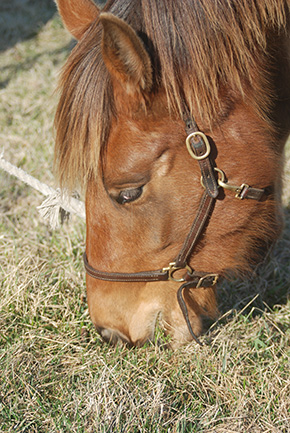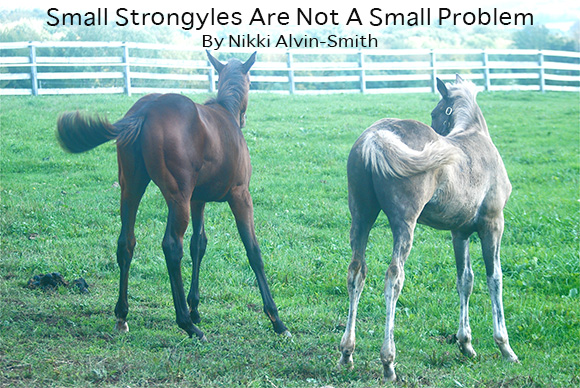Small Strongyles Are Not A Small Problem
By Nikki Alvin-Smith
Our horses are subject to a variety of internal parasites and with the advent of Ivermectin one of the nastiest of the two strongyle groups, the large strongyle worm, has taken a back seat in its prevalence in the equine population. While there are recent studies that indicate it may be on a slight uptick due to dewormer resistance, equine veterinary surgeons do not report seeing the high numbers of large strongyles present in horses when they operate, that they have seen in the past.
The small strongyle however is a different story. The fecal egg worm count or F.E.C.T., measures the worm egg counts of the strongyle worm but it cannot differentiate between the two major types, large and small. The common testing protocol, the simple McMaster technique, is a quantitative measure of worm eggs. Further study of equine fecal samples utilizing methods that develop the eggs into a larval stage are necessary to determine the type of eggs present, and to differentiate between species.
This not to say that regular F.E.C.T. testing is not useful. A good laboratory will routinely have their results check measured by an established laboratory resource to ensure their methods result in accurate findings and occasional random samples may be tested for presence of large strongyle by developing the eggs found into larval stages. As today the large strongyle is not considered a major issue, the count of worm eggs will be mostly the small strongyle variety. Either type is treatable with the same dewormer program, so any report notating a shedding worm egg count can be addressed identically.
It is important when selecting a laboratory for your F.E.C.T. that you work with a laboratory with an experienced technical staff. Not only does the egg count need to be conducted accurately, the technicians also need to be familiar with equine samples. Otherwise pollen grains, mite eggs or other protozoa may be misidentified as worm eggs by the technician.
The Impact of Small Strongyles On The Horse
 Of the varietal equine internal parasites it is the strongyle worm that is responsible for the most damage in horses. It is extremely prolific by nature and all horses will harbor some level of strongyle worms. The small strongyle exists in the lining of the intestine and can cause colic in horses if they are present in large numbers.
Of the varietal equine internal parasites it is the strongyle worm that is responsible for the most damage in horses. It is extremely prolific by nature and all horses will harbor some level of strongyle worms. The small strongyle exists in the lining of the intestine and can cause colic in horses if they are present in large numbers.
As a horse owner you already know to pay attention to any sudden weight loss, diarrhea, colic or signs of intestinal pain in your horse. The chemistry imbalances caused by the small strongyle presence may include an increase in a type of white blood cell, a decreased level of the protein albumin or an increase in globulins in blood fibrous cysts in the gut. All these factors will disrupt nutrient absorption in the horse’s alimentary system and result in extensive fluid loss.
As the small strongyles burrow into the mucosal lining of the large intestine and become encysted there normally for 2-3 weeks, they cause inflammation of the wall of the intestine. They can remain encysted and viable for 2.5 years! The adult small strongyles do not cause the horses much problem even when in high numbers. They do not attach to the lining and suck blood as large strongyles do.
The presence of strongyle worm eggs in a F.E.C.T. should be addressed and monitored, to ensure that the lifecycle is interrupted and to reduce the number of worm eggs available for development into infective larvae on the pasture and in the horse’s environment.
While it is not a common occurrence it is possible that very large numbers of encysted larvae can excyst, that is they exit their encysted stage and shed into the gut of the horse, at the same time. The release of their toxic substances en masse, can cause a syndrome called Larval Cyathostominosis. If you witness a horse suffering from profuse diarrhea, weight loss, ventral edema and dehydration then you should certainly have your vet check for this difficult to diagnose syndrome.
Blood tests may reveal hypoproteinemia and/or anemia, and this syndrome is most commonly seen in horses between one and four years of age and seems to occur most often in winter or early Spring in Northern climates and in the summer in warmer climes. It can occur after deworming so it is prudent to be vigilant for such signs after administration of treatment. While it is smart to be aware of this syndrome’s existence it is not prevalent.
It’s Called Life Cycle Not Life Stasis
With any living organism it is important to consider that there is a life cycle. Treatment by dewormer administration for a reported egg worm count at testing will not kill the strongyle worm in its encysted stage within the horse, where it sits in the mucosal tissue of the intestine or stomach of the horse for a stage in its development.
For this reason F.E.C.T. and retesting is an important part of horse health management.



